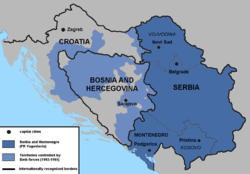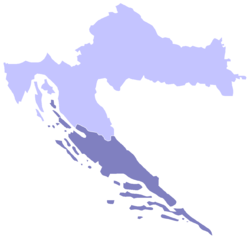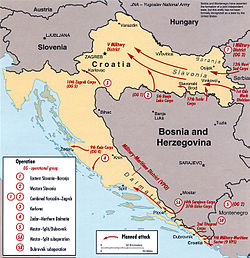- Operation Coast-91
-
Operation "Coast-91" (Obala-91) Part of the Croatian War of Independence Date July - October, 1991 Location Northern Dalmatia, Croatia Result Stalemate - Croatia held the entire coastline near Zadar and Šibenik
- Serb Krajina expanded its territory in the hinterland
Belligerents  SAO Krajina
SAO Krajina
(Serb insurgents) Croatia
CroatiaCommanders and leaders  Milan Babić
Milan Babić
Strength Serb rebel militia
JNA 9th Corps (Knin):
63 tanks
45 APCs
Other units6th Operational Zone (Several infantry brigades) - Log Revolution
- Pakrac
- Plitvice Lakes
- Borovo Selo
- May 1991
- Coast-91
- Opera Orientalis
- Dalj
- Osijek
- Vukovar
- (Battle
- Massacre)
- Šibenik
- The Barracks
- Banski dvori
- Široka Kula
- Dalmatian channels
- Dubrovnik
- Lovas
- Gospić
- Saborsko
- Baćin
- Otkos 10
- Škabrnja
- Erdut
- Orkan 91
- Voćin
- Vihor
- Joševica
- Bruška
- Miljevci
- Tigar
- Maslenica
- Medak Pocket
- Winter '94
- Flash
- Zagreb
- Summer '95
- Storm
- Maestral
- Timeline of all major events
- Events in Serbia
The Operation Coast-91 (Operacija Obala-91) was a Serbian military engagement in Croatia in the northern parts of the coastal region of Dalmatia that took place in the later half of 1991.
The local Serb rebel militia, with extensive support of the Yugoslav People's Army (JNA), launched their attack with the aim of capturing the Croatian coastline and cutting Dalmatia off from the rest of Croatia. The operation as such failed and the JNA was stopped before they could reach the sea, but after it Dalmatia did have severely reduced land links with the rest of Croatia.
Contents
Background
As the Croatian War of Independence began in 1991, the region of Dalmatia (primarily Croat-inhabited) found itself on the borders of the (primarily Serb-inhabited) Krajina region from where the local Serb population orchestrated the Log Revolution in 1990 (a single incident widely viewed by the Croatians as a declaration of war).
On May 2, 1991, the day after Borovo Selo killings of Croatian policemen, the police chief of Polače, a village near Benkovac, Franko Lisica, was killed by supporters of SAO Krajina. The next day, the anti-Serb rioting happened in Zadar and Šibenik. By the end of May, SAO Krajina had held a referendum and formally decided to join the Republic of Serbia.[1]
On July 11, 1991, the Serb paramilitaries placed explosives on the railroad Benkovac-Zadar near Škabrnja.[1]
With escalating civil disobedience concerning all conflicting parties over the next twelve months, the JNA forces became actively involved in August 1991, merely serving as mediators at first. Their first deployment near Zadar was on August 21.[1] This role quickly changed, as the armed forces of Yugoslavia became more Serbianized, to that of open military support for the Serbs. In Dalmatia, Croat areas would soon come under fire from the JNA 9th Corps (9. Korpus, situated in Knin) under the command of the newly arrived Colonel Ratko Mladić who would later become the commander of the Bosnian Serb Army.
Strategic situation and opposing forces
The major strategic problem of Croatia is that the country is very narrow at several places, making it vulnerable to being fragmented. Several such locations lay in Dalmatia, making them an attractive target for the attackers.
The situation was only worsened because the areas under Serb control were situated along the majority of Croatia's eastern borders, making all those locations within reach.
Serb militia (the local territorial defence, "TO") serving as (generously equipped) infantry was actively supported by the 9th Corps. The JNA 9th Corps in Knin was the only JNA Corps subordinate to the JNA Navy command of the Naval District, rather than the land forces of the 5th Army District. Under its command were:
- One armored battalion of some 60 tanks and APCs,
- One motorized infantry brigade (with another 40 tanks and APCs),
- A mixed artillery regiment (rocket launchers and heavy guns),
- One mixed antitank artillery regiment,
- An engineering regiment,
- A Territorial Defence Brigade,
- And support units.
In total, there were 108 armored vehicles attached to these forces. The JNA also had strong garrisons in Šibenik, Zadar and Split over which fighting took place during the Battle of the barracks.
The Croatians had significant infantry, but these were mostly ill-equipped and without any heavy weapons. Until later in the year, some units were even lacking basic equipment like rifles and ammunition. Veterans tell stories of using Coca-Cola cans stuffed with explosives as hand grenades.
On paper, the Croatian army had several infantry brigades under the 6th Operational Zone Command, including those recruited from the population in Zadar (112th) and Šibenik (113th) which took the brunt of the fighting. However, most conscript brigades were actually severely under-strength, being the size of only two reinforced battalions instead of the regular four in brigade organizational system.
Split's 4th "Spiders" Motorized Guard Brigade was the best equipped and trained Croat military unit in Dalmatia. It was used as a mobile reserve, being redeployed to areas needing the greatest firepower.
Like in most of Croatia at the time of 1991, lack of military units forced local Police to be committed to the fighting, as well as peoples volunteer units to be formed.
The battle
Initial operations
History of Dalmatia 
This article is part of a seriesAntiquity Illyria Dalmatae Roman Province Middle Ages Dalmatian principalities Early modern period Republic of Ragusa Republic of Poljica Hvar Rebellion Republic of Venice 19th century Illyrian Provinces Kingdom of Dalmatia 20th century Littoral Banovina Governorate of Dalmatia War of Independence In northern Dalmatia In central Dalmatia In southern Dalmatia
The Serb-led JNA leadership decided to attempt to cut Dalmatia off by striking at three locations: at the vital Maslenica Bridge and the coastal cities of Zadar and Šibenik.
Rebel and JNA forces used the first half of the year to consolidate their territory in the Dalmatian hinterland.[2] Following the takeover of Benkovac, Krajina forces had an important forward base to strike at the coast.
On July 15, 1991, Krajina TO forces started to advance from Benkovac towards Biograd, a costal town between Zadar and Šibenik. It held, and the coastal Zadar-Šibenik road line was maintained, but the frontlines remained close until 1995.
Maslenica and Zadar
At the same time, Serb forces advanced west from Obrovac, targeting Maslenica. On July 26, Croats deployed the 4th Guards Brigade between the two cities, but it managed only to slow the advance.
On July 19, the Territorial Defence in Benkovac started a mobilization.[2] On July 30, Croatian National Guard units were deployed at the village of Miranje near Benkovac in an effort to capture Serb-held road checkpoints.[3]
On September 11, the Serb forces reached the Maslenica Bridge, cutting off the Adriatic Highway, at the time the only remaining land route between Dalmatia and the rest of Croatia. Traffic and supply between Zadar and Senj had to be rerouted via the Pag island route that traversed another bridge further west, across the island of Pag, and then reaching Croatian territory via a ferry line Prizna-Žigljen in the north.
Further southwest Zemunik, an important airfield near Zadar, was captured and Krajina forces advanced on the city. Zadar was heavily shelled from September 15, but the attackers were spread too thin and could not afford troops for a major land attack. Electricity and water supplies were cut to the city for over 100 days and the city was shelled indiscriminately.
On September 18, the Croatian forces were forced to retreat from Polača towards Škabrnja and Raštane. By September 29, the villages of Bulić, Lišane Ostrovičke and Vukšić, located between Benkovac and Skradin, were occupied and pillaged by Serb forces.[2]
Šibenik and hinterland
Skradin north of Šibenik was attacked but not captured in August and the JNA advanced on the major coastal city.
On August 14, the village of Tepljuh northeast of Drniš was the site of the first prisoner exchange in the war.[4]
In the Šibenik hinterland and in the Knin region, the Serb forces advanced during this time. On August 17, the attack on Kijevo started. The village was captured on August 26 and 27. Vrlika was captured on August 25.[5] The destruction of Kijevo and the eviction of Croats from the area was one of the early examples of ethnic cleansing.
On September 15, the Croatian 113th Brigade captured the JNA barracks in the city of Šibenik, and came under heavy combined air, sea, and land attack on September 16. The city theatre, the largest in the country, built in 1870, was destroyed during the shelling. The attack lasted until September 22, when it was finally stopped on the northern bridge leading to the city, at its very outskirts. This became known as the September battle in Šibenik.[6] A total of 269 Croatian soldiers from the Šibenik-Knin county died during the entire war.
The city of Drniš was occupied by the Serb forces on September 16. On September 17, an important power source was captured: the Peruća dam. Further advances were stopped by military units from Dalmatia's capital city of Split and the 126th Brigade from Sinj. After this the line stabilized for the rest of the war.
On September 20, a famous video tape was taken during the Šibenik battles of the Croatian air defence shooting down one attacking Soko J-21 "Jastreb" and one G-2 "Galeb" ground-attack aircraft. The first aircraft was shot at with an anti-aircraft gun, and fell in the sea near island of Kornat, while the second was hit with an SA-7 anti-aircraft missile and exploded over the sea, pilot being killed. Both airplanes were lost, contrary to popular belief that only one was actually shot down.[7] One of the defenders immortalized the tape with the words: "Obadva! Obadva! Oba su pala!" ("Both of them! Both of them! Both have fallen"); which grew into one of the most prominent icons of the war in Croatia.[8]
End of operations
By September 29, the Yugoslav Army decided to abandon the barracks at Zadar and Šibenik, linked to mass desertions.[9]
On October 2, the Serbian forces engaged in a tank and infantry assault on Nadin, but were stopped. The artillery barrages on Zadar continued.[2]
On October 3 the Yugoslav Navy renewed its blockade of the main ports of Croatia.[10]
On October 4, Mladić was promoted to Major-General.
A truce was established on October 6.[2]
Aftermath
Although Operation Coast-91 failed in achieving most of its primary objectives, Dalmatia now had severely reduced land links with the rest of Croatia. Dalmatia had trouble with its electricity, water and food supply for much of the following several years as a result.
The JNA barracks in Split started to evacuate in October, supported by Yugoslav Navy which blockaded and sporadically shelled the city. One of the ships involved in the blockade was the destroyer Split; the first time in history that a city came under attack from a warship bearing its own name.
On October 1, fighting started in the furthest southern part of Dalmatia, which became known as the Siege of Dubrovnik.
In mid-November, the Battle of the Dalmatian channels started as the Croatians broke off the Yugoslav Navy blockade of Split and the surroundings.
On November 18, the village of Škabrnja suffered the Škabrnja massacre.
On November 21, the Maslenica Bridge was destroyed.
By December, the entire line in northern parts of Dalmatia had stabilized and major fighting had stopped entirely.
On December 21, the Bruška massacre happened.
On January 3, 1992 the final ceasefire came into effect and the large scale fighting ended. As part of the ceasefire, the JNA withdrew from most of Croatia and UN peacekeepers came in to patrol the lines between the two armies. In reality, the 9th Corps just passed its equipment down to local Serb units and dissolved.
 Territories of the Republic of Bosnia and Herzegovina and the Republic of Croatia controlled by the Serb forces[note 1], after the Operation Corridor (July 1992).
Territories of the Republic of Bosnia and Herzegovina and the Republic of Croatia controlled by the Serb forces[note 1], after the Operation Corridor (July 1992).
In June 1992, the Miljevci plateau incident briefly disturbed the cease-fire in central Dalmatian hinterland.
The Croatian Army launched Operation Maslenica on January 22, 1993 to reinforce its link with the remainder of Croatia. It was successfully concluded,[citation needed] communications were normalized, and the Maslenica pass was reopened, even though the front lines remained dangerously close to the bridge.
On January 27, 1993, after the Maslenica operation, the UNPROFOR forces at the Peruća dam were attacked by the Serb forces in an attempt to destroy the dam. Explosive charges were detonated, but failed to bring down the dam, after which Croatian forces intervened and recovered the dam (though dysfunctional) and the surrounding area.[11]
The rest of occupied Dalmatia would remain under Serb control until Operation Storm in 1995 when the Krajina was overrun by the Croatian Army.
Notes
- ^ According to the prosecution of War Crimes Tribunal, "Serbian forces" included Yugoslav Army, Serb Territorial Defense of Bosnia and Herzegovina and Croatia, Republic of Srpska Krajina Army, Army of the Republika Srpska, territorial defense of Serbia and Montenegro, Police of Serbia and Police of Republika Srpska, including national security, special police forces of Krajina known as "Martićevci", as well as all Serbian paramilitary forces and volunteer units
References
- ^ a b c http://www.hic.hr/ratni-zlocini/hrvatska/dalmacija/kronologija.htm
- ^ a b c d e Josip Čerina (July 2008). "Branitelji benkovačkoga kraja u Domovinskom ratu" (in Croatian). Drustvena istrazivanja: Journal for General Social Issues (Zagreb, Croatia: Institute of Social Sciences Ivo Pilar). ISSN 1330-0288. http://hrcak.srce.hr/index.php?show=clanak&id_clanak_jezik=40170&lang=en. Retrieved 2011-01-24.
- ^ "Jesu li Miru Barešića ubili njegovi ljudi ili četnici?" (in Croatian). Vjesnik. 2002-09-17. http://www.vjesnik.hr/pdf/2002%5C09%5C17%5C05A5.PDF. Retrieved 2011-01-24.
- ^ "Hrvatski branitelji zarobljenici kninskih logora u Tepljuhu postavili spomen ploču" (in Croatian). Radio Drniš. http://www.radiodrnis.hr/jm/index.php?option=com_content&view=article&id=200%3Ahrvatski-branitelji-zarobljenici-kninskih-logora-u-tepljuhu-postavili-spomen-plou&Itemid=17. Retrieved 2011-01-24.
- ^ "Vijenci, svijeće i molitve u Sinju i Vrlici za poginule branitelje" (in Croatian). Slobodna Dalmacija. 2010-08-25. http://www.slobodnadalmacija.hr/Split-%C5%BEupanija/tabid/76/articleType/ArticleView/articleId/113660/Default.aspx. Retrieved 2011-01-24.
- ^ (Croatian) Šibenik city guide - history section
- ^ List of Jugoslav aircraft losses since 1945 (Croatian)
- ^ YouTube video
- ^ "Army Leaves More Towns in Croatia". Los Angeles Times. September 29, 1991. http://articles.latimes.com/1991-09-29/news/mn-4747_1_army-barracks. Retrieved December 13, 2010.
- ^ "Petnaesta obljetnica operacije Peruča - Spriječena katastrofa" (in Croatian). Hrvatski vojnik (Ministry of Defence (Croatia)). February 2007. http://www.hrvatski-vojnik.hr/hrvatski-vojnik/1232007/peruca.asp. Retrieved 2011-01-24.
- Thomas, Nigel; Mikulan, Krunoslav; Pavlović, Darko (2006). The Yugoslav Wars (1): Slovenia & Croatia 1991-95. Elite #138. Osprey Publishing. ISBN 1841769630.
- Basic data on operation Coastline '91
- JNA Order of battle for operation Coastline '91
Categories:- Conflicts in 1991
- Battles of the Croatian War of Independence
- History of Dalmatia
- Battles involving Serbia
- 1991 in Croatia
Wikimedia Foundation. 2010.


